<< Previous | Displaying results 2826-2850 of 6771 for "" | Next >>
Under SA guard, a group of leading Socialists arrives at the Kislau camp, one of the early concentration camps. Local Social Democratic party leader Ludwig Marum is fourth from the left in the line of arrivals. Kislau, Germany, May 16, 1933.
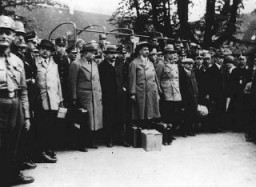
A sign, in both German and Latvian, warning that people attempting to cross the fence or to contact inhabitants of the Riga ghetto will be shot. Riga, Latvia, 1941–43.
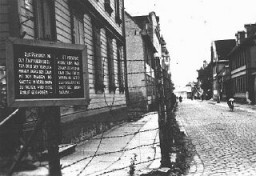
Deportation of Jews from Hanau, near Frankfurt am Main, to the Theresienstadt ghetto. Hanau, Germany, May 30, 1942.

Jews forced into the Kovno ghetto move their belongings into the ghetto. In the center, a man is pulling a disassembled wardrobe. He was never able to put it together because of the crowded conditions in the ghetto. Clothes were often hung from nails in the wall instead. Lithuania, ca. 1941-1942.
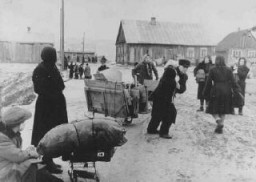
Arrival of a transport of Dutch Jews in the Theresienstadt ghetto. Czechoslovakia, February 1944.
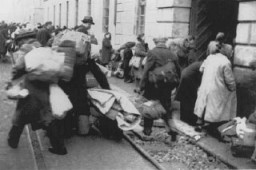
Yakob Vizgordiski works at a machine in a ghetto factory. Kovno, Lithuania, between 1941 and 1943.
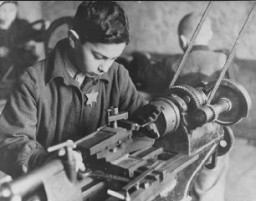
An emaciated child eats in the streets of the Warsaw ghetto. Warsaw, Poland, between 1940 and 1943.
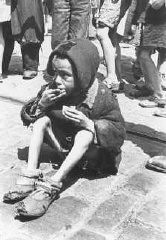
Children eating in a Warsaw ghetto street. Warsaw, Poland, between 1940 and 1943.
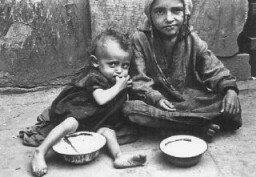
Deportation of Jewish children from the Lodz ghetto in German-occupied Poland during the "Gehsperre" Aktion, September 1942.
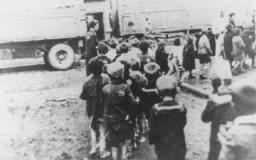
Jewish resistance fighters who were captured by SS troops during the Warsaw ghetto uprising. Warsaw, Poland, April 19-May 16, 1943. The original German caption reads: "These bandits offered armed resistance."
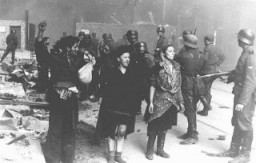
Jews carrying bundles of possessions who were forced to gather at an assembly point before their deportation from the Kovno ghetto, probably to Estonia. Kovno, Lithuania, October 1943. This photograph was taken by George Kadish.
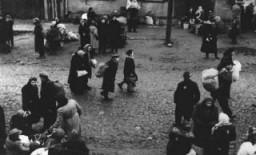
A synagogue used as a warehouse for the belongings of deported Jews. Szeged ghetto, Hungary, 1944.

Ruins of a building in the Kovno ghetto gutted when the Germans attempted to force Jews out of hiding during the final destruction of the ghetto. Photographed by George Kadish. Kovno, Lithuania, August 1944.
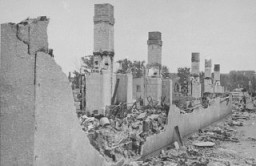
Commercial area on Nalewki Street in Warsaw's Jewish quarter. Warsaw, Poland, 1938.
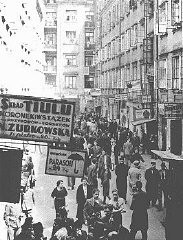
Men, women, and children dig defense ditches during the German siege of Warsaw. Poland, September 1939.

German forces and Polish civilians on the outskirts of Warsaw. In the background of the photograph, the city burns as a result of the German military assault. Warsaw, Poland, September 1939.
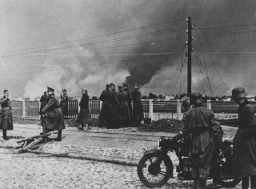
German personnel on Grzybowska Street arrest and search Jewish men who supposedly hid weapons prior to the German occupation of Warsaw. Warsaw, Poland, October-December 1939. This is one of a series of photos taken by Arthur Grimm, an SS propaganda company photographer, documenting the investigative work of the Sicherheitsdienst (SD) in occupied Warsaw for the Berliner Illustrierte Zeitung. Although only some of the photos were published, it is likely that the incidents depicted in the BIZ were staged…
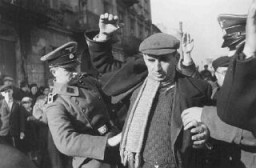
In the Warsaw ghetto, Jewish children with bowls of soup. Warsaw, Poland, ca. 1940. During the Holocaust, the creation of ghettos was a key step in the Nazi process of brutally separating, persecuting, and ultimately destroying Europe's Jews. Ghettos were often enclosed districts that isolated Jews from the non-Jewish population and from other Jewish communities.
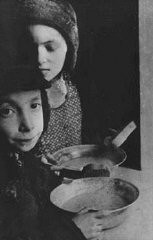
Street scene in the Warsaw ghetto. The sign at left announces: "Soup in the courtyard, first floor, apt. 47." Warsaw, Poland, 1940-1941.
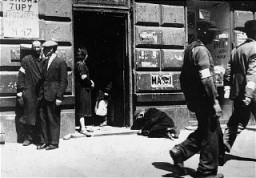
A Warsaw ghetto resident gives money to two children on a Warsaw ghetto street. Warsaw, Poland, between October 1940 and April 1943.
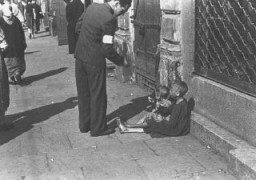
An emaciated woman sells the compulsory Star of David armbands for Jews. In the background are concert posters; almost all are destroyed. Warsaw ghetto, Poland, September 19, 1941. This photograph was taken by Heinrich Joest, a German army sergeant during World War II. On September 19, 1941, he took 140 images of every aspect of life and death in the Warsaw ghetto.
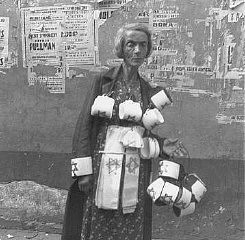
Entrance to the Warsaw ghetto. The sign states: "Epidemic Quarantine Area: Only Through Traffic is Permitted." Warsaw, Poland, February 1941.

Polish civilians walk by a section of the wall that separated the Warsaw ghetto from the rest of the city. Warsaw, Poland, 1940–41.
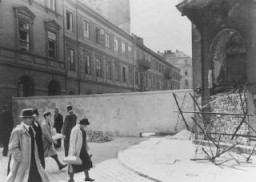
Stall of a street vendor selling old Hebrew books. Warsaw ghetto, Poland, February 1941.
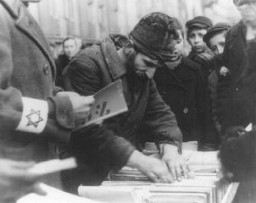
A Polish policeman checks the papers of a Jewish resident of the Warsaw ghetto. Warsaw, Poland, February 1941.
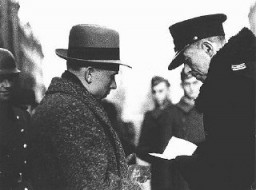
We would like to thank Crown Family Philanthropies, Abe and Ida Cooper Foundation, the Claims Conference, EVZ, and BMF for supporting the ongoing work to create content and resources for the Holocaust Encyclopedia. View the list of donor acknowledgement.